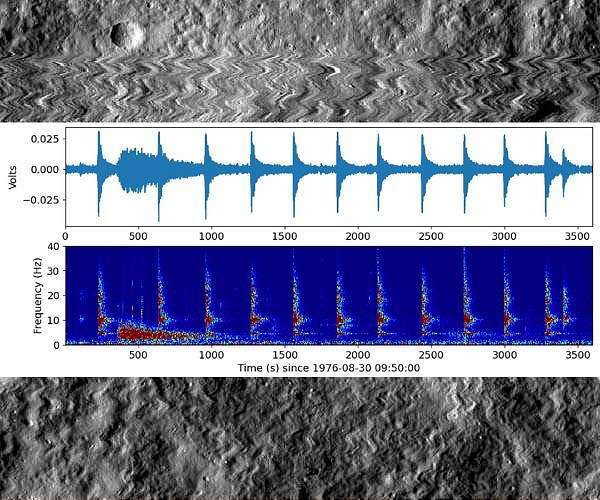12.09.2023

Seismic signatures of regularly occurring moonquakes.
Every morning and afternoon, like clockwork, the surface of the Moon trembles with tiny "moonquakes." Now, new analysis of seismic activity on the Moon has characterized these events and discovered that some of them are not what they seem.
The new research is described in a study appearing in the Journal of Geophysical Research - Planets on September 5.
Without an atmosphere to insulate it, the Moon experiences drastic temperature variation, from up to 250 degrees Fahrenheit during the peak of the day to -208 F at night. These extreme swings cause the Moon's surface to expand when it's hot and contract when it's cold, and this movement leads to small shaking and cracking near the surface called thermal moonquakes.
In the 1970s, astronauts from the Apollo 17 mission placed an array of three seismometers on the Moon that could measure thermal moonquakes. The seismometers collected data over a period of eight months, from October 1976 to May 1977. The data remained largely untouched until recently. In the new study, this lunar seismic data has been reanalyzed with modern techniques like machine learning.
Led by Francesco Civilini, a recent Caltech postdoc, the research shows that thermal moonquakes occur with precise regularity, every afternoon as the Sun leaves its peak position in the sky and the surface of the Moon begins to cool off. But the study's machine-learning model also detected additional signatures of seismic activity in the morning that looked different from the evening moonquakes. Surprisingly, these turned out not to be thermal moonquakes after all.
The researchers were able to triangulate the source of the shaking and found that the morning tremors were actually coming from the Apollo 17 lunar lander base, a few hundred meters away. As the structure heated and expanded in the morning, its creaking vibrations were detected by the seismic array.
"Every lunar morning when the sun hits the lander, it starts popping off," says Allen Husker, research professor of geophysics and co-author on the new study. "Every five to six minutes another one, over a period of five to seven Earth hours. They were incredibly regular and repeating."
Understanding lunar activity is critically important, as NASA intends to return astronauts to the Moon within a few years with the Artemis missions and ultimately establish a lunar base. Though thermal moonquakes are too small to be felt by anyone standing on the Moon's surface, the findings give important insights into the thermal contraction and expansion that future lunar landers and equipment should be designed to experience. Husker says it is likely that landers from other Apollo missions also experience this creaking and expansion, though seismometers from those missions were designed to measure different frequencies than thermal moonquakes.
Additionally, quakes both on the Earth and Moon are a useful way to study what is happening underground. Seismic waves travel at different speeds through different materials, so researchers can infer what materials are underground by measuring seismic signatures. "We will hopefully be able to map out the subsurface cratering and to look for deposits," Husker explains. "There are also certain regions in craters at the Moon's South Pole that never see sunlight; they are permanently shadowed. If we could put up a few seismometers there, we could look for water ice that may be trapped in the subsurface; seismic waves travel slower through water."
There are no plate tectonics or volcanic activity on the Moon, but researchers still have many open questions about the Moon's internal structure.
"It's important to know as much as we can from the existing data so we can design experiments and missions to answer the right questions. The Moon is the only planetary body other than the Earth to have had more than one seismometer on it at a time. It gives us the only opportunity to thoroughly study another body," says Husker.
The paper is titled "Thermal moonquake characterization and cataloging using frequency-based algorithms and stochastic gradient descent." Husker, Civilini, and Renee Weber of the NASA Marshall Space Flight Center are the paper's authors. Funding was provided by NASA.
Quelle: SD

